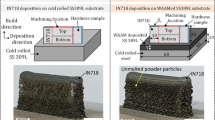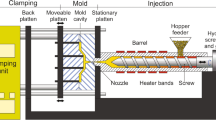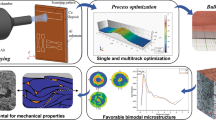Abstract
Conformal cooling channels (CCCs) are widely employed in the plastic injection molding (IM) due to uniform cooling in the cooling stage. IM is a process that molten materials are pushed into the mold cavity. The cooling stage is an important part in the IM process since it takes most of the cycle time. According to practice experience, it is very difficult to improve the cycle time and quality of injection molded part simultaneously in the conventional straight drilled cooling system. Thus, improving warpage and cooling time simultaneously of the injection molded parts is a critical item in the IM. In this study, an effective method for reducing both warpage and cooling time of the wax patterns was proposed by changing the coolant temperature difference between the core and cavity inserts. It was found that both core insert with series connection CCCs and cavity insert with parallel connection CCCs is a good combination in the IM mold. The cooling efficiency of the core insert is increased from 42 to 54%, while the coolant temperature difference between the core and cavity inserts is 2 °C. The average deformation of the injection molded parts can be improved by 75.2%. The cooling time of the injection molded parts can be further reduced by 6%. The cooling time of the injection molded parts can be saved by about 30%, and the average deformation of the injection molded parts can be improved by about 60% compared with IM mold embedded with conventional cooling channel. The mechanism to minimize the amount of warpage of injection molded parts using coolant temperature difference between the core and cavity inserts is presented. Finally, the proposed method is also verified by practical implementation and comparison with experimental data. The experimental results found that the improvement rate of the average deformation of the molded parts is up to 74.5% and the cooling time of the molded parts can be reduced by approximately 15.7%. The variances compared with the simulation results are approximately 0.7% and 9.7%, respectively.
























Similar content being viewed by others
Code availability
Not applicable.
References
Huang W-T, Tsai C-L, Ho W-H, Chou J-H (2021) Application of intelligent modeling method to optimize the multiple quality characteristics of the injection molding process of automobile lock parts. Polymers 13:2515
Dong YW, Li XL, Zhao Q, Yang J, Dao M (2017) Modeling of shrinkage during investment casting of thin-walled hollow turbine blades. J Mater Process Technol 244:190–203
Kuo C-C, Chen W-H (2021) Improving cooling performance of injection molding tool with conformal cooling channel by adding hybrid fillers. Polymers 13:1224
Kitayama S, Miyakawa H, Takano M, Aiba S (2017) Multi-objective optimization of injection molding process parameters for short cycle time and warpage reduction using conformal cooling channel. Int J Adv Manuf Technol 88(5–8):1735–1744
Wang X, Li Z, Gu J, Ruan S, Shen C, Wang X (2016) Reducing service stress of the injection-molded polycarbonate window by optimizing mold construction and product structure. Int J Adv Manuf Technol 86(5–8):1691–1704
Brooks H, Brigden K (2016) Design of conformal cooling layers with self-supporting lattices for additively manufactured tooling. Addit Manuf 11:16–22
Vojnová E (2016) The benefits of a conforming cooling systems the molds in injection moulding process. Procedia Eng 149:535–543
Mercado-Colmenero JM, Rubio-Paramio MA, Marquez-Sevillano JDJ, Martin-Doñate C (2018) A new method for the automated design of cooling systems in injection molds. Comput Aided Des 104:60–86
Lim WS, Choi HS, Ahn SY, Kim BM (2014) Cooling channel design of hot stamping tools for uniform high-strength components in hot stamping process. Int J Adv Manuf Technol 70(5–8):1189–1203
Chen J, Gong P, Liu Y, Zheng X, Ren F (2017) Optimization of hot stamping cooling system using segmented model. Int J Adv Manuf Technol 93(1–4):1357–1365
Singraur DS, Patil BT, Rampariya Y (2019) Advancements in design and fabrication of conformal cooling channels for improvement in plastic injection molding process. Ind Eng J 12(5):1–6
Mercado-Colmenero JM, Martin-Doñate C, Rodriguez-Santiago M, Moral-Pulido F, Rubio-Paramio MA (2019) A new conformal cooling lattice design procedure for injection molding applications based on expert algorithms. Int J Adv Manuf Technol 102(5–8):1719–1746
Abbès B, Abbès F, Abdessalam H, Upganlawar A (2019) Finite element cooling simulations of conformal cooling hybrid injection molding tools manufactured by selective laser melting. Int J Adv Manuf Technol 103(5–8):2515–2522
Li Z, Wang X, Gu J, Ruan S, Shen C, Lyu Y, Zhao Y (2018) Topology optimization for the design of conformal cooling system in thin-wall injection molding based on BEM. Int J Adv Manuf Technol 94(1–4):1041–1059
Liu C, Cai Z, Dai Y, Huang N, Xu F, Lao C (2018) Experimental comparison of the flow rate and cooling performance of internal cooling channels fabricated via selective laser melting and conventional drilling process. Int J Adv Manuf Technol 96(5–8):2757–2767
Yasin SBM, Mohd NF, Mahmud J, Whashilah NS, Razak Z (2018) A reduction of protector cover warpage via topology optimization. Int J Adv Manuf Technol 98(9–12):2531–2537
Izadi O, Silani M, Mosaddegh P, Farzin M (2018) Warpage and bending behavior of polymer–metal hybrids: experimental and numerical simulations. The Int J Adv Manuf Technol 98(1–4):873–885
Kwak JB (2019) Completely in situ and non-contact warpage assessment using 3D DIC with virtual patterning method. Int J Adv Manuf Technol 100(9–12):2803–2811
Sun X, Su X, Mao J, Tibbenham P, Tao J, Bao Z (2016) The application of modified viscoplastic constitutive relationship on the warpage prediction of injection-injection molded part. Int J Adv Manuf Technol 86(9–12):2517–2526
Chung C-Y, Hwang S-S, Chen S-C, Lai M-C (2021) Effects of injection molding process parameters on the chemical foaming behavior of polypropylene and polystyrene. Polymers 13:2331
Pan C-T, Lin C-H, Huang Y-K, Jang JSC, Lin H-K, Kuo C-N, Lin D-Y, Huang JC (2021) Design of customize interbody fusion cages of Ti64ELI with gradient porosity by selective laser melting process. Micromachines 12:307
Zhu Y, Wang D, Fang C, He P, Ye Y-H (2019) A multilayer emitter close to ideal solar reflectance for efficient daytime radiative cooling. Polymers 11:1203
Funding
This study received financial support from the Ministry of Science and Technology of Taiwan under contract nos. MOST 109–2637-E-131–004 and MOST 107–2221-E-131–018.
Author information
Authors and Affiliations
Contributions
Chil-Chyuan Kuo: wrote the paper/conceived and designed the analysis/performed the analysis/conceptualization. Yu-Xin Xu: collected the data/contributed data or analysis tools.
Corresponding author
Ethics declarations
Ethics approval
Not applicable.
Conflict of interest
Not applicable.
Additional information
Publisher's Note
Springer Nature remains neutral with regard to jurisdictional claims in published maps and institutional affiliations.
Rights and permissions
Springer Nature or its licensor holds exclusive rights to this article under a publishing agreement with the author(s) or other rightsholder(s); author self-archiving of the accepted manuscript version of this article is solely governed by the terms of such publishing agreement and applicable law.
About this article
Cite this article
Kuo, CC., Xu, YX. A simple method of improving warpage and cooling time of injection molded parts simultaneously. Int J Adv Manuf Technol 122, 619–637 (2022). https://doi.org/10.1007/s00170-022-09925-3
Received:
Accepted:
Published:
Issue Date:
DOI: https://doi.org/10.1007/s00170-022-09925-3




